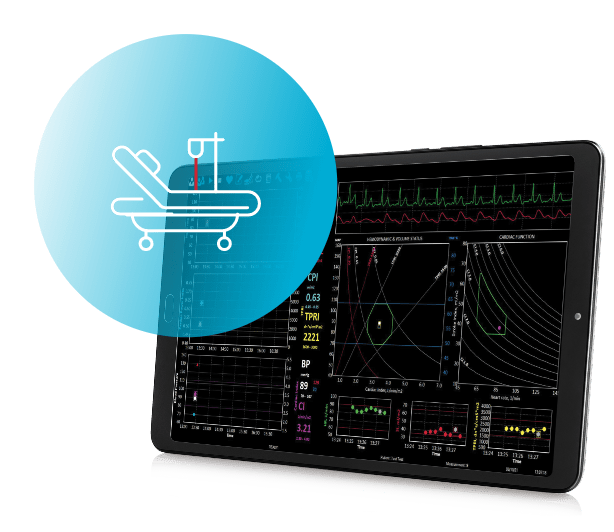ICU/ICCU
NICaS can assist physicians in determining the patient’s body composition. With NICaS, physicians can also determine the cause of hypertension or hypotension, based on each patient’s objective hemodynamic parameters. These parameters provide the physician with a deeper understanding of the total dynamics that cause patients’ individual hemodynamic status and fluctuations.
Challenges
Assess fluid status and fluid responsiveness.
Monitor and treat hypotensive/hypertensive patients.
Evaluate drug response and drug titration online.
Solutions
NICaS helps reduce the length of hospital stay and/or patient mortality.
Personalized treatment according to individual hemodynamic profiles: Stop guessing what medication to administer.
View trends of the hemodynamic profile on a specially designed screen that is easy to operate and understand.
NICaS helps physicians to be more effective in determining the proper dry weight, fluid volume status and prescriptions. With NICaS, they can prescribe the proper medication that best addresses the specific cause of each condition.
ICU/ICCU In Numbers:
$4,300 – The average cost per day of a bed in a U.S. ICU
$108B – Approximate total annual U.S. ICU costs
4.1% – of the national health expenditure in the U.S

Related Clinical Markets
Related Clinical Studies
Utility of NICaS Non-Invasive Hemodynamic Monitoring in Critically Ill Patients with COVID-19
Authors: Wisam Zabeeda, Jonah Benjamin Cohen, Anat Reiner Benaim, Shiri Zarour, Yael Lichter, Idit Matot, Or Goren Conclusion: Non-invasive hemodynamic monitoring via the NICaS device
Comparison of non-invasive hemodynamic monitoring by bioimpedance and echocardiography in cardiac intensive care unit patients
Authors:N. Kofman; A.;A. Rotmansh; E. Kalmanovich Conclusion: Even in the hands of cardiologists trained in performing echocardiographic hemodynamic evaluations, the measurement consistency is relatively low.
Lack of Concordance Between Parameters Defining Cardiogenic Shock in Patients With ST Elevation Myocardial Infarction
Authors: Triston Eastman, Mirna Ragheb, Mullein Thorleifson, Brett Hiebert, Kunal Minhas, Malek Kass, Amir Ravandi and Ashish Shah Conclusion: Our study is the first to
Accurate noninvasive continuous monitoring of cardiac output by whole body electrical bioimpedance
Authors: Gad Cotter , Yaron Moshkovitz, Edo Kaluski, Amram J Cohen, Hilton Miller, Daniel Goor, Zvi Vered The results of the study indicate that the
The Clinical Research of NICaS for Monitoring Changes of Cardiac Function in Patients with Sepsis (two part study – part 1)
Authors: Zhu Yan Second Military Medical University CONCLUSION: NICaS can measure the cardiac output and stroke volume in sepsis patients as accurate as ultrasonic Cardiogram,
Intradialytic exercise increases cardiac power index
Authors: Brent Momb, Samuel Arlington Headley, Tracey Matthews, Michael J. Germain In conclusion, exercise during dialysis may decrease the likelihood of experiencing ischemic or hypotensive
Whole-body bioimpedance monitoring for outpatient chronic heart failure follow up
Authors: Yusuke Tanino, Junya Shite, Oscar L Paredes, Toshiro Shinke, Daisuke Ogasawara, Takahiro Sawada, Hiroyuki Kawamori, Naoki Miyoshi, Hiroki Kato, Naoki Yoshino, Ken-ichi Hirata Conclusion:
Whole-body electrical bio-impendance is accurate in non invasive determination of cardiac output: A thermodilution controlled, prospective, double blind evaluation.
Authors: Guillermo Torre-Amione, Olga Milo, Edo Kaluski, Zvi Vered, Gad Cotter NICaS is a novel accurate noninvasive method for CO determination. The results of this
The reliability of noninvasive cardiac system hemodynamic monitoring in the cardiac intensive care patient requiring mechanical circulatory support
Authors: Guido Tavazzi, Policlinico San Matteo Pavia Fondazione, A Fernandez-Gasalla, Ana Barradas-Pires, Yoseph Mebrate Conclusion: Both Pearson correlation and linear regression demonstrated an excellent correlation
